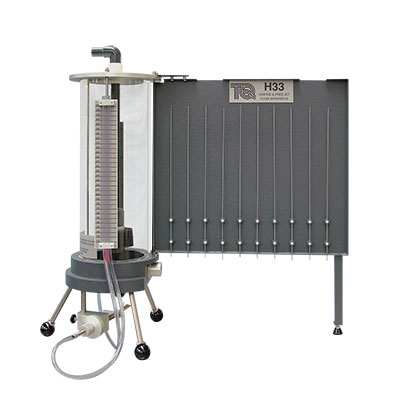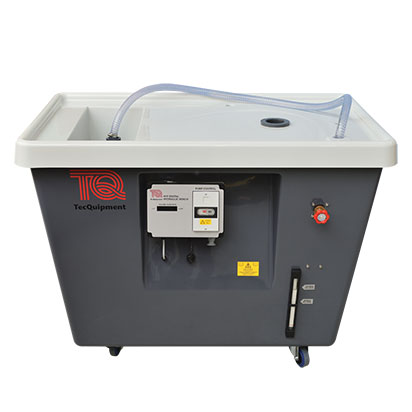Description
TecQuipment’s Jet Trajectory and Flow Through an Orifice apparatus allows students to measure:
- Decrease in flow
- Contraction of the stream
- Energy loss
They make these measurements as water discharges from four vertically mounted, interchangeable nozzles with different throat (orifice) designs.
It also allows students to study the trajectory profiles of water jets from the nozzles when mounted horizontally. The equipment is for use with a hydraulic bench (H1F) and stands on the hydraulic bench worktop. The apparatus has a transparent cylindrical tank, with a mounting in the base for the nozzles. The nozzles either fit to the unit to discharge water vertically (down) or horizontally dependent on the experiment taking place. They are easily interchangeable.
Water flows into the tank from the hydraulic bench through an adjustable diffuser. The flow rate and an overflow pipe set the water level. To change the level in the tank (and so the head on the orifice), students adjust the flow to the diffuser. Water leaves the tank through the nozzles. The jet that leaves the orifice discharges into the hydraulic bench measuring tank.
Manometers measure the total head on the orifice and under the jet. A traverse assembly allows students to position a Pitot tube anywhere in the jet. A sharp blade accurately measures the jet diameter. This allows students to find the contraction coefficient.
To measure trajectory of jets, the base of the tank includes a horizontal mounting for the nozzles. Students use a bung to seal the base of the unit. They then use the plotting board and depth gauge pins to plot the jet trajectory onto graph paper.
Key features:
- Supplied with four interchangeable nozzles with different throat (or orifice) designs
- Nozzles mount vertically and horizontally
- Simple and clear plotting of horizontal jet trajectory
- Direct measurement of total head, head loss and diameter of a vertical water jet
- Integral Pitot traverse with blade to measure head in the vertical jet and diameter of jet
- Works with TecQuipment’s Hydraulic Bench for easy installation
Learning outcomes:
- Determination of the contraction and velocity coefficients
- The calculation of the discharge coefficient.
- Determination of the actual discharge coefficient by measurement of flow rate for comparison against calculated value.
- Determination of the above over a range of flow rates to show the influence of Reynolds number.
- Determination of discharge characteristics (jet trajectory) for an orifice mounted in the side of a vertical tank and comparison with simple theory.






